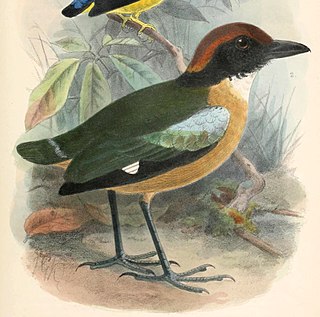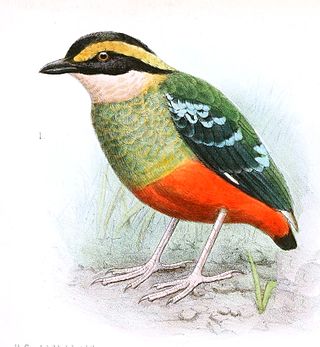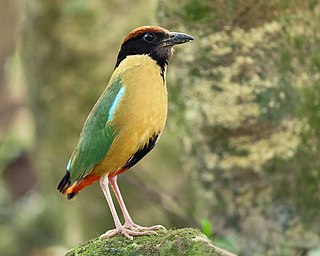
Pittas are a family, Pittidae, of passerine birds found in Asia, Australasia and Africa. There are 44 species of pittas, all similar in general appearance and habits. The pittas are Old World suboscines, and their closest relatives among other birds are in the genera Smithornis and Calyptomena. Initially placed in a single genus, as of 2009 they have been split into three genera: Pitta, Erythropitta and Hydrornis. Pittas are medium-sized by passerine standards, at 15 to 25 cm (5.9–9.8 in) in length, and stocky, with strong, longish legs and long feet. They have very short tails and stout, slightly decurved bills. Many have brightly coloured plumage.

Gurney's pitta is a medium-sized passerine bird. It breeds in the Malay Peninsula, with populations mainly in Myanmar. The common name and Latin binomial commemorate the British banker and amateur ornithologist John Henry Gurney (1819-1890). Its diet consists of slugs, insects, and earthworms.

The superb pitta is a large pitta that is endemic to Manus Island which lies to the north of Papua New Guinea.

The rainbow pitta is a small passerine bird in the pitta family, Pittidae, endemic to northern Australia, most closely related to the superb pitta of Manus Island. It has a velvet black head with chestnut stripes above the eyes, olive green upper parts, black underparts, a bright red belly and an olive green tail. An Australian endemic, it lives in the monsoon forests and in some drier eucalypt forests.

The fairy pitta is a small and brightly colored species of passerine bird in the family Pittidae. Its diet mainly consists of earthworms, spiders, insects, slugs, and snails. The fairy pitta breeds in East Asia and migrates south to winter in Southeast Asia. Due to various habitat and anthropogenic disruptions, such as deforestation, wildfire, hunting, trapping, and cage-bird trade, the fairy pitta is rare and the population is declining in most places. Listed on the Convention on International Trade in Endangered Species of Wild Fauna and Flora (CITES) Appendix II, this bird is classified as vulnerable on the IUCN Red List of Threatened Species.

The black-faced pitta is a species of bird in the family Pittidae. It is found on Bougainville Island in Papua New Guinea, and Choiseul Island as well as Santa Isabel Island in the Solomon Islands. Its natural habitat is subtropical or tropical moist lowland forest. It is threatened by habitat loss and most certainly by introduced predators and/or competitors.

The African pitta is an Afrotropical bird of the family Pittidae. It is a locally common to uncommon species, resident and migratory in the west, and an intra-African migrant between equatorial and southeastern Africa. They are elusive and hard to observe despite their brightly coloured plumage, and their loud, explosive calls are infrequently heard. The plump, somewhat thrush-like birds forage on leaf litter under the canopy of riparian or coastal forest and thickets, or in climax miombo forest. They spend much time during mornings and at dusk scratching in leaf litter or around termitaria, or may stand motionless for long periods. Following rains breeding birds call and display from the mid-canopy.

The blue-headed pitta is a species of bird in the pitta family Pittidae. It is endemic to Borneo.

The blue pitta is a species of bird in the family Pittidae found in the northeastern Indian subcontinent, southern China, and Indochina. It typically lives in moist forests but can also inhabit dry forest. It is an unobtrusive, solitary bird which feeds by foraging on the ground for insects and other small invertebrates.

The elegant pitta is a species of passerine bird in the pitta family Pittidae. It is endemic to Indonesia, where it is found in the Lesser Sunda Islands and Moluccas.

The garnet pitta is a species of bird in the family Pittidae. It is found in Brunei, Indonesia, Malaysia, Myanmar, Singapore, and Thailand. Its natural habitat is subtropical or tropical moist lowland forest. It is threatened by habitat loss. The form occurring in the Malaysian state of Sabah has been split as the black-crowned pitta.
The whiskered pitta is a rare species of bird in the family Pittidae. It is endemic to Luzon in the Philippines. This bird is the largest pitta in the country reaching 23 cm long and 116 g in mass. It has a brownish head, blue breast, and red belly. It has broad ash malar or "whiskers". Its natural habitat is tropical moist lowland forest and tropical moist montane forest. It is threatened by habitat loss and trapping. It is one of the most sought after birds by birdwatchers in the Philippines.

The blue-winged pitta is a passerine bird in the family Pittidae. It forms a superspecies with three other pittas, the Indian pitta, the fairy pitta and the mangrove pitta. A colourful bird, it has a black head with a buff stripe above the eye, a white collar, greenish upper parts, blue wings, buff underparts and a reddish vent area. Its range extends from India to Malaysia, Indonesia, southern China and the Philippines. Its habitat is moist woodland, parks and gardens and it avoids dense forest. It feeds mainly on insects and worms. It breeds in the spring, building an untidy spherical nest on the ground, often near water and between tree roots. A clutch of about five eggs is laid and incubated by both parents, hatching after about sixteen days.

The green-breasted pitta is a species of bird in the family Pittidae. It is one of only two Pitta species in Africa, and is found in deep forest of the tropics.

The azure-breasted pitta is a species of bird in the family Pittidae. It is a striking and colorful bird having colors of red, azure, green, black and white, It is endemic to the islands of Mindanao, Bohol, Leyte and Samar in the Philippines. Its natural habitat is tropical moist lowland forest. It is threatened by habitat loss.

The graceful pitta, sometimes alternatively known as the black-crowned pitta, is a species of bird in the family Pittidae. It occurs in Sumatra in Indonesia, where its natural habitat is subtropical or tropical moist montane forests. It is threatened by habitat loss.

The noisy pitta is a species of bird in the family Pittidae. The noisy pitta is found in eastern Australia and southern New Guinea. It eats earthworms, insects and snails. Its natural habitats are temperate forests, subtropical or tropical moist lowland forest, and subtropical or tropical moist montane forest.

The black-crowned pitta, also known as the black-headed pitta, black-and-crimson pitta, black-and-scarlet pitta or black-crowned garnet pitta, is a brightly coloured, ground-dwelling, bird species in the pitta family. It is endemic to the Southeast Asian island of Borneo. It was described by John Gould in 1877, with the type locality recorded as the Lawas River in northern Sarawak.

The Malayan banded pitta is a species of bird in the family Pittidae. Other common names include the blue-tailed pitta, the Irene's pitta, the banded pitta and the Van den Bosch's pitta. It is found in Thailand, the Malay Peninsula and Sumatra. It was formerly considered conspecific with the Bornean and Javan banded pittas, together they were referred to as the banded pitta, but now they are considered to be separate species.

The ornate pitta is a species of bird in the family Pittidae. It is found in Indonesia. Its natural habitat is subtropical or tropical moist lowland forest. It is threatened by habitat loss.



















